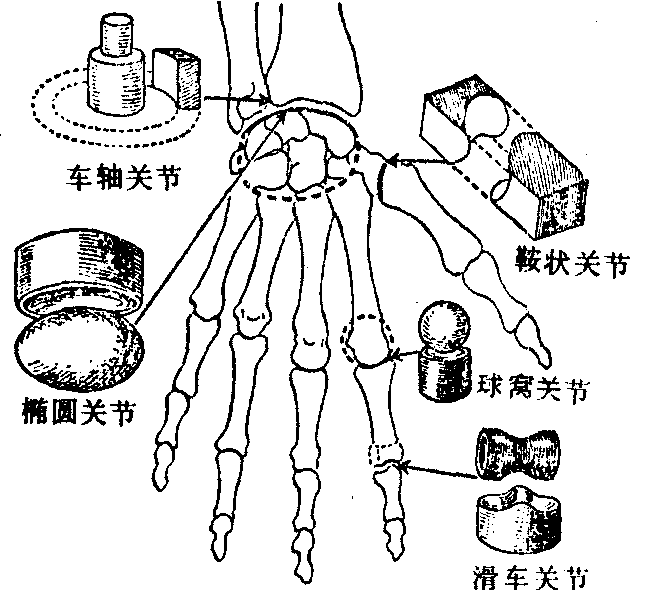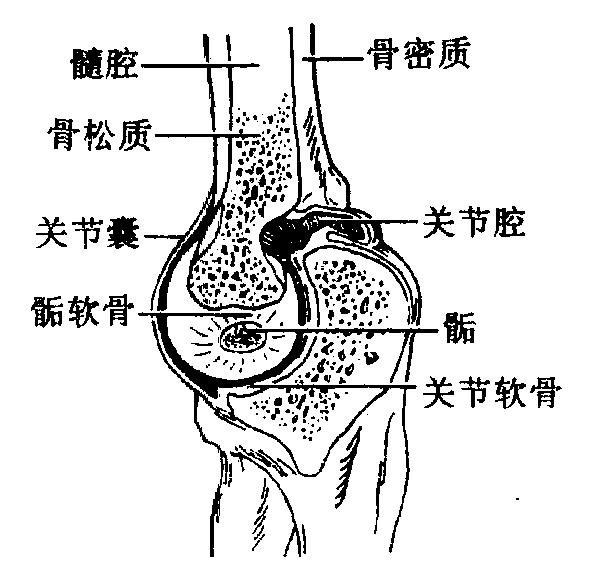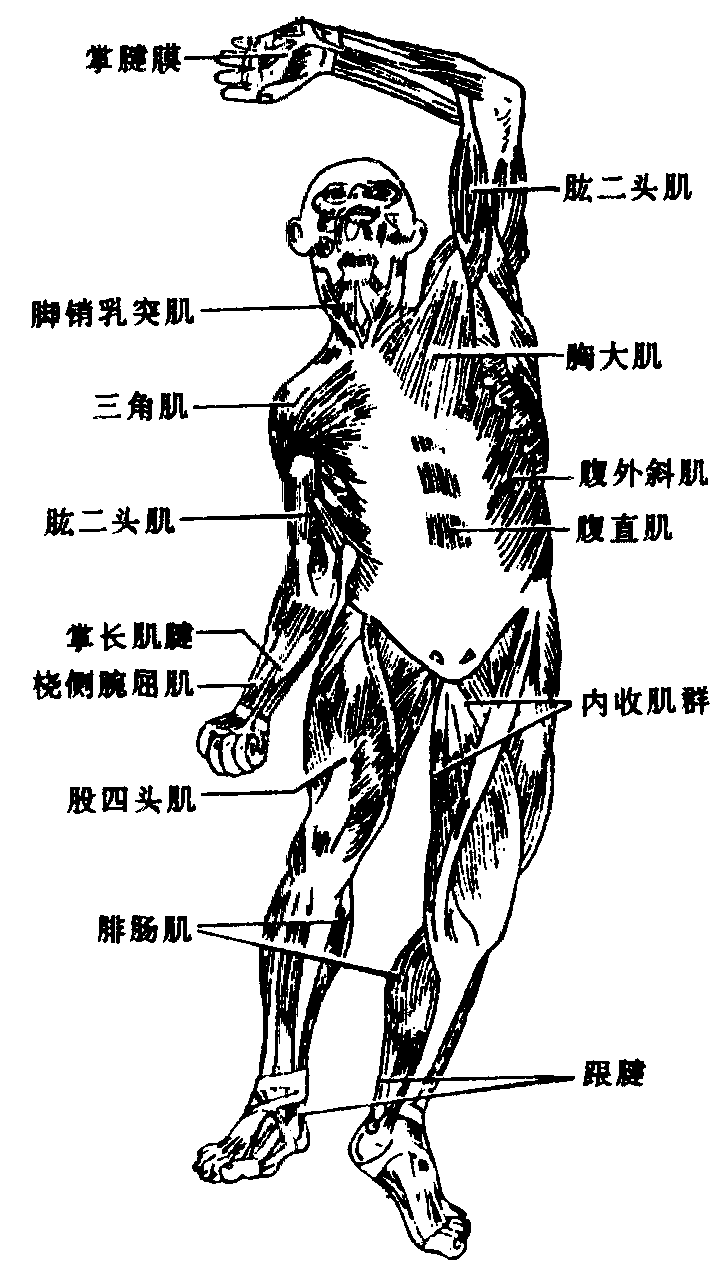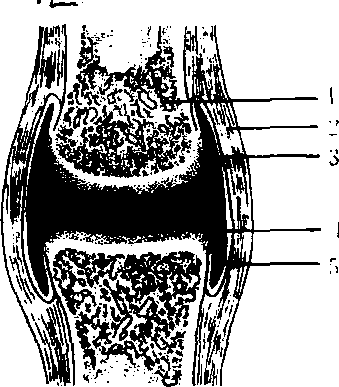关节guanjie
能活动的骨连结叫做关节,它是骨连结的主要形式,一般由关节面、关节囊和关节腔三部分构成。关节面是两个以上相邻骨的接触面,一个略凸,叫关节头,另一个略凹,叫关节窝。关节面上覆盖着一层光滑的软骨,可减少运动时的摩擦,软骨有弹性,还能减缓运动时的震动和冲击。关节囊是很坚韧的一种结缔组织,把相邻两骨牢固地联系起来。关节囊外层为纤维层,内层为滑膜层,滑膜层可分泌滑液,减少运动时的摩擦。关节腔是关节软骨和关节囊围成的狭窄间隙,正常时只含有少许滑液。有些关节还有一些辅助结构: 如韧带是连结骨与骨之间的结缔组织束,成为关节囊的增厚部分,可加强骨连结的稳固性; 关节盘或关节半月板是位于两关节面之间的纤维软骨,能使两骨关节面的形状相互适应,减少运动时的冲击,有利于关节的活动。关节在肌肉的牵引下,可作各种运动。运动形式有: 屈是相连两骨之间的角度减小,伸是角度增大; 内收是肢体向正中矢状面靠拢,外展是离开正中矢状面; 旋转是骨绕本身的纵轴(垂直轴)转动,如肢体的前面转向内侧是旋内,肢体的前面转向外侧是旋外; 屈、伸、内收、外展的复合运动即是环转,这时骨近端在原位转动,远端作圆周运动,全骨运动面呈圆锥形。

图488 关节的类型
关节
两块骨或更多骨连接在一起,连接部分具有一定活动功能的,叫做关节。关节由关节面、关节囊和关节腔组成(见图1.3-3)。关节面上覆盖着关节软骨,其表面光滑,有利于关节运动,而且关节软骨的弹性好,可缓和运动时的冲击和震荡。关节囊是密封的,其腔称为关节腔。关节囊分为外层和内层,外层为纤维层,结构坚实。内层为滑膜层,可分泌滑液,滑液在关节腔内有滑润关节、减少运动时关节面间摩擦的作用。不同关节的结构特点不同,与其功能有密切关系,例如膝关节的关节面平坦,接触面大,关节囊紧张,因而活动度小;而肩关节的关节面弯曲度大、关节囊松弛,关节活动灵活。

图1.3-3 关节的构造

图1.3-4 肌肉
关节guanjie
骨与骨之间能活动的连接。有的骨连结不能活动,如脑颅骨的连接; 有的能稍微活动,如椎骨的连接,这些都不能称作关节。关节是骨连接的主要形式。全身各关节都由关节面、关节囊和关节腔构成(见图)。关节面是组成关节的相邻两骨的接触面、其中一个为凸面,另一个为凹面。关节面上覆盖着一层软骨,有减少两骨间摩擦和减轻两骨相撞的作用。附着在关节面周围及其附近骨面上的结缔组织为关节囊,把两骨牢固地联系起来。囊腔内表面能分泌滑液,以减少骨与骨之间的摩擦。关节囊内的空腔为关节腔,内含少量的滑液。关节腔内为负压,对维持关节的稳定性有一定的作用。关节囊的外面还有一些坚韧的韧带,把两骨更牢固地联系住。关节的这种结构,既牢固,又灵活。

关节的构造
关节Guan jie
骨连接的主要形式,由两骨或更多骨连在一起,具有一定活动能力的结构。每个关节都有关节囊、关节面和关节腔。关节面为相邻两骨的接触面,多为一凸一凹,凹面称关节窝, 凸面称关节头, 两者彼此适应。关节面的表面有一层关节软骨, 可以减少摩擦和两骨撞击时的冲力; 关节囊是附着于关节面周缘和邻近骨面上的结缔组织囊, 分为内外两层,外层厚而坚韧,有的地方明显增厚为囊韧带,具有加强骨间连接,制止关节过度运动等作用,内层薄而柔软,能分泌滑液;关节腔是关节囊围成的腔,其内含少量滑液。当关节发炎时,腔内大量积液,引起关节肿胀和疼痛。关节面、关节腔和滑液使关节灵活;关节囊、韧带及附近的骨胳肌使关节牢固而稳定。

1.骨 2.关节腔 3.关节面4.关节囊 内层 5.关节囊外层
关节剖面的结构
关节可进行屈和伸、内收和外展、旋内和旋外,环转等运动。关节的运动与关节的结构有关,受关节面形状的制约,如指关节只能做屈、伸运动,而肩关节可以做上述各种形式的运动。
体育锻炼可以增加关节的灵活性,加强关节的牢固性。若关节长期不活动,易出现僵直或引起损伤。当关节受到强大外力作用时,如用力过猛或跌倒,有可能使关节面离开正常的解剖位置,称为脱臼。特别是儿童和少年易出现这种现象。脱臼时常伴有关节囊撕裂,韧带损伤,关节肿胀,严重的可暂时失去运动能力,因此在平时的活动中要防止脱臼的发生,若发生脱臼,应注意保护脱臼关节的稳定,及时就医,切勿盲目进行复位,以免引起不良后果。
关节
由两块或多块骨间接连结组成。相对骨面之间有间隙,骨与骨的关节面没有直接联系,而是以关节囊包裹连结,可作灵活运动的,称动关节——肢型,或称滑膜关节,即为通常所说的典型关节。若两骨的相对面的连结紧密,其间无间隙,不能活动,称不动关节——颅型,或为暂时关节,少动或微动称少动关节——椎型。
关节
是骨与骨之间借结缔组织相连构成的活动枢纽。根据连结组织的性质和活动情况,可将关节分为不动关节、半关节和动关节三类。
❶不动关节:两骨之间以结缔组织相连结,中间没有任何缝隙,又叫无腔隙连结。如前臂骨和小腿骨之间的韧带联合,椎骨之间的软骨结合以及坐骨、耻骨和髌骨之间的骨性结合等。
❷动关节:相邻骨之间的连结组织中有腔隙的连结,又叫有腔隙骨连结,通常称关节。人体绝大部分骨连结属于此种类型,共有200多个,如肩关节、肘关节、腕关节、髋关节、膝关节、踝关节等。它们是骨转动的枢纽(即支点或支轴)。
❸半关节:是动关节和不动关节之间的过渡连结方式。其特点是两骨之间以软骨组织直接相连结,软骨内有呈裂缝状的腔隙,活动范围很小,如耻骨联合。
关节
旧称暗中行贿、说人情为通关节。为达到某种目的而通关节之事,历朝屡见不鲜。科举制度创立后,士子为争中式,请托公卿显贵,贿赂考官,均称关节。清制,关节作为科举考试用语,除上述内容外,又指考官与考生之间先期约定的暗号,于考试时标明卷中。由于有弥封、誊录之法,考官阅卷时不知考卷为何人所作,故有此舞弊手段,以便考官发现此卷。亦称“关目”。这在各级考试中都存在。如事先约定某几个虚字、连用几个相同的字,或将某一词散见于点题中。清代某科题为“子谓子夏曰”全章,某考生与考官事先约定破题中连用四个“一”字,结果于破题中书“儒一而为不一,圣人一勉之一诫之焉”。为防止这种舞弊手段,清政府曾规定必须使用的虚字,并于誊录时删去某些虚字不录。
关节articulatio
❶又称滑膜连结。 骨连结的方式之一。由关节面、关节软骨和关节囊组成。相对的两个关节面相互吻合,其形状与运动有关;关节软骨覆于关节面上,有减少磨擦和缓冲震动的作用;关节囊为附于相邻两骨关节面周缘的结缔组织膜,内层的滑膜有保护关节的作用。囊内滑液有润滑、缓冲、营养关节、排出代谢产物的作用。多数关节具韧带,有加固关节的作用。从构成关节骨数可分两类:单关节,仅由两枚骨连结而成,如肩关节;复关节,由两枚以上的骨组成,如腕关节和膝关节,使运动复杂化并增强了关节的坚固性。运动有伸屈、收展和旋动等方式。广义的关节即骨连结,还包括纤维连结和软骨连结,此两者合称不动关节,上述的滑膜连结则称动关节。
❷在节肢动物联结肢节间或体节间的模样构造,柔软、环形,由没有硬化的角质层构成。